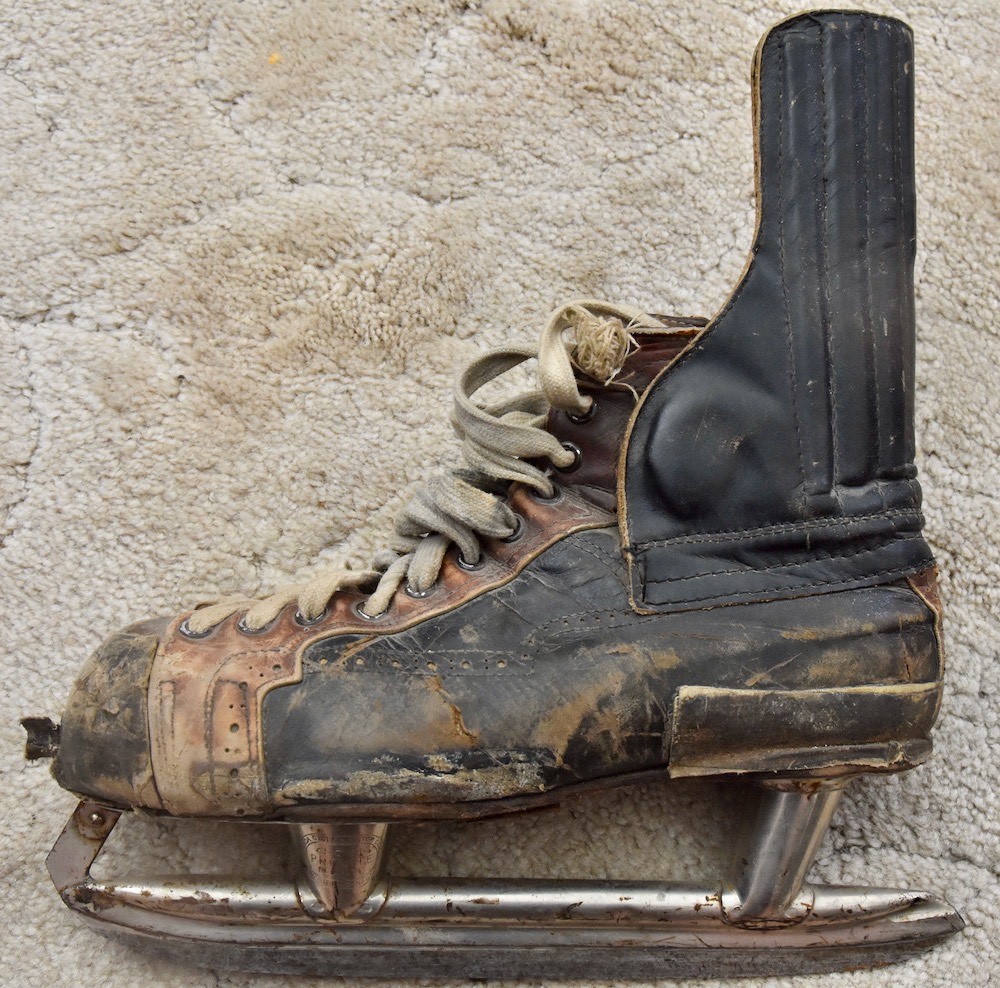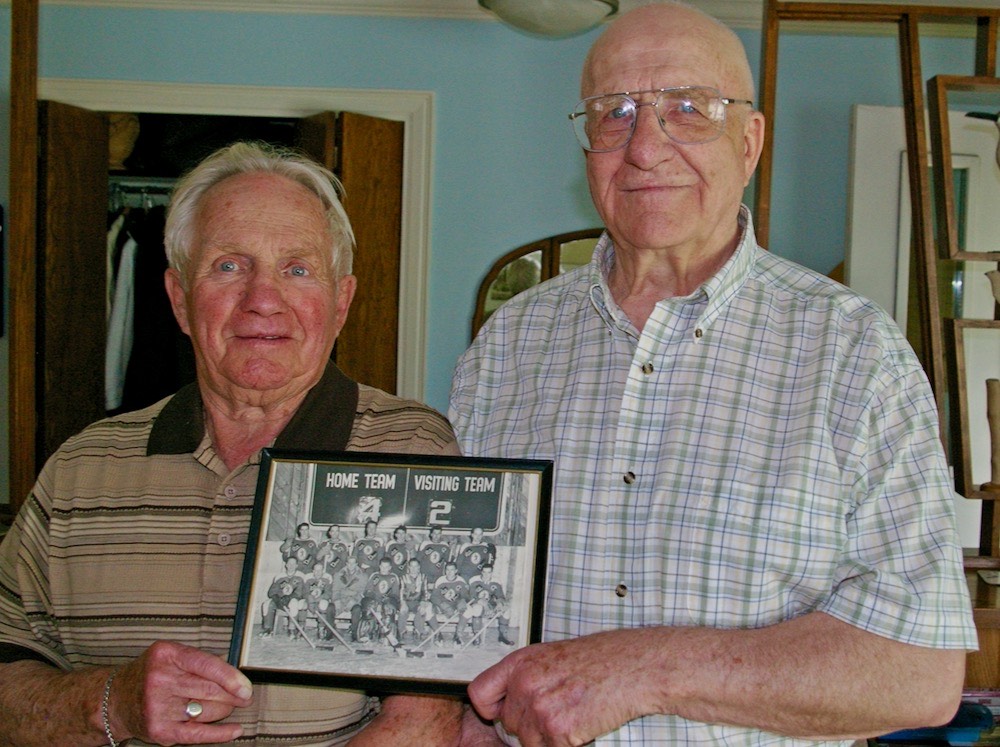WHAT’S IN A SKATE? BILLY’S TACKS

Billy Jr. and Billy Sr. proudly display this well worn pair of Tacks. Photo by Stan Neufeld
At the age of sixteen when I (Stan) began playing senior hockey for the Grande Prairie Athletics. I obtained my first pair of “Tacks” thanks to a deal from my coach, Pete Wright. He owned Wright’s Sporting Goods Store on Richmond Ave. at the time. I suspect he may have lost money on that sale. Pete was good to kids he thought were short of money.

Pete Wright owned a sporting goods store on Richmond Avenue and posted this advertisement with various media in the city. Stan Neufeld photo collection
What’s In A Skate? - Ancient History to Modern Technology
Wikipedia tells us the Finns, gave us the first iteration of skates in about 3000BC. They strapped animal bones to their feet and used poles for propulsion to traverse the vast expanses of ice that covered their country. Norway and Sweden improved upon animal bones by attaching wooden blades to their feet. Further research reports that in the fourteenth century AD the Dutch were the first to strap iron blades to their boots making it possible to obtain traction without the use of poles. They enabled skaters to push and glide – a movement they called the Dutch Roll. Many kids when Billy was young learned to skate on Bob skates. In my opinion anyone who can master anything more than balancing and skating forward in a straight line on Bob skates might well be the next Barbara Ann Scott of figure skating or the Guy LaFleur of hockey. I failed to ask Billy if he and his brother ever used Bob skates.
This highly condensed version of the earliest account of skates brings us to the early part of this century and Canada’s contribution to the finely tuned skates hockey players currently wear. It is the product of competition between Bauer and CCM for supremacy in the market for skates and hockey equipment today. CCM dominated the skate market in the early part of the century with their “Automobile Skate” (it utilized the material that was used in the manufacture of the Russel Motor car). For a brief period the Bauer Supreme skate took over first place with the introduction of the first skate with the blade already attached to the boot. CCM responded quickly with a boot to match or surpass the Bauer Supreme. It was the Tackaberry - named after Manitoba’s George E. Tackaberry (1874 – 1937). George Tackaberry from Brandon, Manitoba was a maker of orthopedic shoes for people with mobility disabilities. In 1905 Tackaberry’s neighbour, a tough and rugged NHL hockey player, Joe Hall presented Tackaberry with a challenge to which he responded and has made his name famous in hockey circles. Hall complained that the skates he wore could not withstand a full season of the punishment they took on the ice.
The boot Tackaberry designed featured a lower boot, snugly fitting reinforced heels and toes, arch supports he designed, a thicker tongue and moisture-resistant kangaroo hide that would not stretch out of shape. In 1927 CCM took over Tackaberry’s operation and seven years later introduced a skate that featured the Tackaberry boot attached to their new heat-treated Prolite blade made of Sheffield steel – the strongest tube skate that CCM had ever made. NHL super star Conacher endorsed the skate as “light and lively enabling you to skate fast, shift quickly or stop instantly and it fit like a glove.” The competition between Bauer and CCM for supremacy in skate and hockey equipment sales is ongoing. When Billy Bessent, and I (Stan) were still playing the game our preference was the Tack and we were wiling to make sacrifices to obtain them.

Close up look at Billy’s Tackaberry. Photo by Stan Neufeld

Bert Bessent’s Grande Prairie Midgets. Photo courtesy of Billy Bessent.
Back: Bert Bessent – coach
Front row: Bill Card, Frank Stojan, Max Henning, Jackie Bromley, Herb Shields, Charlie McAuley, Bob Bessent, Bill Bessent, Unknown, Norman Boyce, Fran Tanner
Billy and Bobby defied age restrictions signing up with the RCAF at age seventeen.

Hand shake between father and son (Bert and Billy). Photo courtesy of Billy Bessent
They graduated as gunners and in Halifax boarded the Queen Mary for England and active service overseas. As far as we know Billy and Bobby did not play hockey overseas like their buddies, Charlie Turner, Roy Wright and several others. The wartime teams in England did not know what they missed by overlooking the Bessent twins. Perhaps they were considered too small to play the game with the big boys. How wrong they were. Billy and Bobby could hold their own in any company and I would be willing to bet that their skates made the journey overseas with them and they would have been available. Sadly Bobby did not survive the war. Following a bombing mission his plane crash-landed in heavy fog. Except for the pilot and tail gunner the crew perished as the plane burned. The pilot watched in horror.
Max and Billy’s Legacy
Two veterans of WW11 and Grande Prairie ice hockey heroes are still with us here in Grande Prairie - Billy Bessent and Max Henning. Both are decorated war veterans having received the Distinguished Flying Medal of Honour.

Max Henning and his medal. Photo by Stan Neufeld

Billy and his crew. Photo courtesy of Billy Bessent

Billy Bessent and Max Henning wore sweaters like these representing five different local senior hockey teams-think of the history. Photo by Stan Neufeld

Billy and Max presented this photo to Stan Neufeld in 2002 and planted a seed for creation of the Grande Prairie Legends of Hockey project . They are founding committee members who have now passed the torch to sons Bill and Cam so the Bessent-Henning legacy lives on. Photo by Stan Neufeld
We don’t know if Max ever owned a pair of Tacks. I (Stan) do recall a conversation with Max in which he reported that during the depression funds for hockey equipment and skates were very limited. He wore magazines for shin pads held in place by tire tube rubber rings and fought with other kids for sticks that were broken during senior games they watched. “I remember my first pair of skates. They were old style tube skates that my Dad purchased for $4.95 – three sizes too big so I would not quickly grow out of them. We could trade in our old skates for new ones at the local hardware store but that was too expensive so old skates were repaired as long as they fit. I was a “trend-setter” when I purchased a new pair of CCMs with diamond shaped tubes. I was flattered, when others including hockey Legend Charlie Turner who was twelve years older followed my lead.” (Max).
What’s In A Skate? - Modern Technology
So you ask again – What’s in a pair of skates? Here’s what – the ability of a hockey player to rush down the ice and in the confined space of a hockey rink (200 X 85 ft) reach speeds of up to 20mph while dipsy doodling around a defenseman. Conversely skates enable a defenseman to make quick lateral moves preventing tricky forwards from reaching the goalie. What would a hockey player do to own a pair of Tacks? How about splitting a mountain of wood for a neighbour? How about shoveling tons of snow from driveways in town? or spending hours on the corner of 101st and Richmond Ave. in the numbing cold as a street seller of Edmonton Journals for a few bucks? - anything for a pair of Tacks.
Billy – when you are no longer with us we will proudly show off your skates. They will remind us your story and our hockey history.

Billy Bessent with his Red Devils photo on the wall of the Legends Lounge at the Coke Centre. Photo by Stan Neufeld
Grande Prairie Hockey Legends is researched, written and presented by Stan and Ron Neufeld